Understanding the intricate world of boiler tubes is essential, as they are the workhorses behind boilers’ efficiency. These components transfer heat from the boilers’ combustion chamber to surrounding water or steam – but they’re not all the same. Each type of boiler tube has unique characteristics, and which one your facility needs depends on your circumstances.
Join us as we delve deeper into the diverse array of boiler tubes, their unique characteristics, and their optimal uses in various industrial settings.
Understanding and Choosing Types of Boiler Tubes
Boiler tubes facilitate heat exchange between combustion gases and the water or steam circulating within the boiler. They come in various shapes and sizes, are usually made of steel, and can be tailored to specific operating conditions and performance requirements based on a facility’s unique needs. Let’s delve into some of the most common boiler tube types and their uses.
1. Fire Tube Boiler Tubes
In fire tube boilers, combustion gases move through the interior of the tubes, heating the surrounding water. These tubes are usually made of stainless steel or carbon steel and are notable for their sturdiness and resistance to high temperatures. They are often used in heating, process steam generation, and small-scale power generation applications.
2. Water Tube Boiler Tubes
In water tube boilers, combustion gases flow through water-filled tubes. This design enhances heat transfer efficiency and allows for operation at higher pressures. Water tube boiler tubes are often made from metals like stainless steel or alloy steel, which offers superior strength and resistance to corrosion. Facilities like power plants, chemical processing plants, and marine propulsion systems commonly use water tube boiler tubes.
3. Economizer Tubes
Economizer tubes improve boiler efficiency by preheating the feedwater using residual heat from combustion gases. These tubes are typically installed in the boiler’s flue gas path and withstand high temperatures and thermal stressors. Economizer tubes usually consist of carbon steel or low-alloy steel. Many types of industrial boilers employ these tubes, including coal-fired boilers and waste heat recovery systems.
4. Superheater Tubes
Superheater tubes increase the temperature of steam beyond its saturation point, enhancing its energy content and thermal efficiency. Because superheater tubes experience extreme temperatures and thermal cycling, they must be built with materials that offer next-level heat resistance and strength. Superheater tubes usually consist of chromium-molybdenum steel or nickel-based alloys. They are vital components in power generation plants and industrial steam processes.
5. Reheater Tubes
Reheater tubes play a complementary role to superheater tubes. These tubes reheat steam that has undergone expansion in the turbine to maintain its temperature and to prevent condensation. These tubes regularly exist alongside high temperatures and pressure, requiring materials that can withstand thermal fatigue and creep. Reheater tubes are usually constructed from alloys that have the ability to handle high temperatures and resist corrosion. They are used in large-scale power generation facilities and cogeneration systems.
6. Condenser Tubes
Condenser tubes facilitate heat transfer from steam to a cooling medium – usually water – which helps the steam condense into liquid form. Condenser tubes are exposed to a corrosive environment thanks to dissolved oxygen and other contaminants in the cooling water. Because of this, condenser tubes are often made of materials like copper alloys or titanium since these metals are known for their thermal conductivity and ability to resist corrosion. You’ll often find condenser tubes in power plants, refrigeration systems, and air conditioning units.
Boiler tubes form the backbone of boiler systems, and each type plays a unique – yet interconnected role – in optimizing thermal performance and reliability. Understanding the nuances of boiler tube design, materials, and applications is paramount for ensuring safe and efficient boiler operation across a spectrum of industries. These indispensable boiler tubes power progress — and it’s essential that each facility relying on them knows how to choose the right one for their needs.
How to Choose Which Type of Boiler Tube Your Facility Needs
Industrial Boilers America manufactures and supplies high-quality ASME standard steel boiler tubes to customers worldwide. Our advanced inspection and testing processes ensure that our boiler tubes can handle the most challenging conditions and meet your facility’s needs.
If your needs are complex, our engineers can provide you with exact specifications or help you design the precise boiler tube you’re looking for. We offer ready-to-ship tubes for a wide range of needs.
With over 20+ years of industry experience, we can help you make the most cost-effective and efficient decision for your facility. Contact us today to get started on choosing the best boiler tubes for you.


